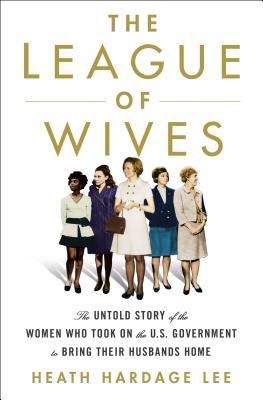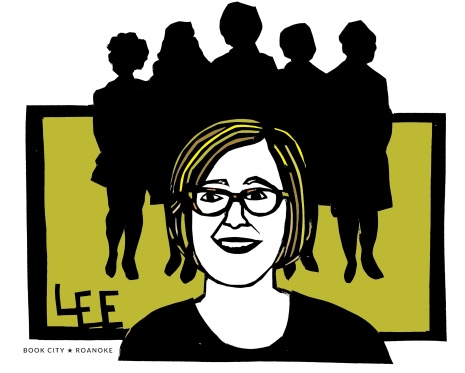There are shelves of nonfiction books subtitled with words like “forgotten”, “untold”, and “hidden”. As a society, we’ve overlooked extraordinary leaders in historic moments. They are women, people of color, activists, and those fighting for change against powerful forces within entrenched systems. Fortunately, there are talented researchers and writers with the commitment to bring these stories to light. And in this case, the stories make for compelling work.
 With her second book, an exhibit, and a forthcoming film project, Roanoke author Heath Hardage Lee is capturing the story of how wives of Vietnam prisoners of war and soldiers missing in action fought for years for the return of their husbands. They battled political and bureaucratic forces, finding surprising allies and often disappointing Federal leadership. Their campaign had no book of proven strategies. These wives wrote it, and they became important national leaders in their own right.
With her second book, an exhibit, and a forthcoming film project, Roanoke author Heath Hardage Lee is capturing the story of how wives of Vietnam prisoners of war and soldiers missing in action fought for years for the return of their husbands. They battled political and bureaucratic forces, finding surprising allies and often disappointing Federal leadership. Their campaign had no book of proven strategies. These wives wrote it, and they became important national leaders in their own right.
As we await the April 2 publication date of League of Wives: The Untold Story of the Women Who Took on the U.S. Government to Bring Their Husbands Home from Vietnam (St. Martin’s Press, 2019) we checked in with Heath for some behind-the-scenes on putting together the book.
BOOK CITY ★ Roanoke: This was a complex story with political and policy aspects as well as the personal stories of a number of military families. What was your process like in originally organizing the information?
Heath Hardage Lee: I spent several years reading everything possible about the Vietnam War, the POWs and MIAs and the little that was out there about the wives’ movement to get the POWs out and the MIAs accounted for. Then I began interviewing all the primary figures I had identified. Each woman got her own 3 ring binder and I put anything related to that woman in her binder and supplemented that with an electronic folder for each woman and each political figure that was important to the story. The primary sources I found: diaries, letters, telegrams, meeting minutes-really helped the story come together.

BCR: Wow. That’s a lot of work, and it paid off. I can picture you surrounded by binders. I can imagine the sense of obligation you felt to get it right. Certainly, you could have told this story in a number of different ways, such as choosing on primary League leader as a focus. At what point did the structure take shape for you?
HHL: I started with the Phyllis Eason Galanti papers at the Virginia Museum of History and Culture in Richmond, Virginia. The staff had told me to take a look at these as they knew I was looking for a new “hidden history” kind of story about women who had had a national impact. Phyllis is one of the stars of my story: her papers led me all over the country to dozens of women important in the POW MIA movement. I soon found that Sybil Stockdale was the founder of the movement and the National League of Families for Prisoners and War and Missing in Southeast Asia. So she was the natural center. Jane Denton, Louise Mulligan, Andrea Rander, Helene Knapp and others were chosen as representative wives because all of them were part of the original National League leadership. I chose to focus on the intersection of the women-when and where did they interact with each other? How did this bind them all together?
BCR: What other avenues did you consider?
HHL: I really didn’t consider doing this another way. But I knew what I did NOT want to do: to write vignettes of each woman separately with no interaction. That format is used a lot and I really don’t like it as it puts characters apart from each other. It is important to show dynamism, energy and interaction among the women. Isolating them in separate portraits felt dead to me.
BCR: That really came through. I especially enjoyed the scenes of the local gatherings in San Diego and then of the women forming the nationwide network. With the exhibit, you already know how people respond to some of the stories. What kind of response has the exhibit had in Colorado?
HHL: The show has had a massive response! Over 75,000 visitors during its 9 month run. We hope for the same at our other venues.
BCR: Wow! Congratulations. The exhibit is now open at the Virginia Museum of History and Culture through September 3. This will be the first time someone can choose to either read the book or visit the exhibit as their first introduction to the story. Of course they should do both, but do you have any thoughts–read first or visit first?
HHL: Ideally, I would love for people to read the book first, BUT I think different people learn and absorb information differently. This story begged for multiple platforms! I encourage people to read the book AND see the exhibit as each enhances the other and reading the book and seeing the exhibit will give you a more holistic view of the story and the Vietnam War era. And eventually you will be able to see the movie too!
BCR: That’s right—the book has been optioned. Will you be closely involved in the film project?
HHL: Yes! I am thrilled to say I am an executive producer on the film and already consulting on it. I will be going out to the set once we start filming and will be helping the screenwriter with the script. I feel like I will learn so much from this process, and I am so excited to be involved with Hello Sunshine and Fox 2000 on the project.
BCR: That’s really exciting. Maybe you’ll talk to me again about that as the project progresses? For now though, I want to know more about writing the book. It felt as if the voices of league members informed the narrative voice. Were one or two of the women foremost in your mind or did one of them influence your voice in the writing?
HHL: That is totally correct. The two women who informed the book the most were Sybil Stockdale and Jane Denton. This was because both were leaders of the POW MIA movement. But it was also because Sybil and Jane’s families were each kind enough to entrust me with their diaries. The personal details and memories in each of these primary sources were invaluable. And I quote directly from both so you truly hear these women’s exact voices from the Vietnam era.
BCR: You give a very good sense of cultural shifts during an era of dramatic change, dropping in cultural cues, including music references. Do you listen to music as you work?
HHL: What was so interesting about this book is that I was never particularly into music before. But the music during the Vietnam era is what defines the time like no other art form from that period. So I started listening to the music from the era for context while I was writing. Things like “Hotel California” by the Eagles seemed to perfectly encapsulate what the POWs were going through while “I am Woman” by Helen Reddy symbolized the empowerment that the POW MIA wives felt toward the end of their ordeal. The music particularly helped me to shape the narrative.
BCR: What an interesting period in our history. The early pacing of the chapters really pulls the reader along with the story. Was chapter development tricky with such a complex story that drew out over 8 years?
HHL: The first chapters were such fun to write-especially the parts about the protocol manuals like The Navy Wife. While they seem like dusty artifacts now, they were like Bibles for military wives in the 1950s and 1960s. And every chapter presented such drama, such life and death scenarios, it just seemed to write itself. When you get to the middle, I wanted you to feel all the back and forth and how frustrated these women were getting, particularly with their government, and at the end you finally get your resolution. So it really wasn’t tricky at all to write. It was almost like a Duchamp “ready made” in that sense. This was a story that just needed some good framing and context to make people see how important it was and what heroines these ladies were.
BCR: As a reader, I did feel the frustration. And then I really got a sense of their tenacity. They led the way in unchartered territory. Somehow the cover captures that—it’s terrific. These women who clearly bridge eras are in two different directions with a variety of expressions. Did you work with the cover illustration artist? What was the conversation like regarding the desired effect?
HHL: I did work closely with the St. Martin’s Press cover artist on the cover images. The middle figure is Phyllis Galanti who I mentioned earlier that is from a photo I own. The other ladies came from a Nixon Presidential Library image taken in 1969 of the other women at a Nixon press conference. It was important to show the real women with clothes from the era—I think their personalities really shine through on that cover and it pulls you back to the late 1960s without needing much explanation.
BCR: You are tapping lots of different parts of your creativity in this project. You’ve been closely involved with this material for a long time now. What has been most surprising in bringing the book to life?
HHL: That no one before me thought to write about these women! It makes me mad in some ways that this story was ignored for so long. But it makes me happy to know I am the one who gets to tell it!
BCR: Well, thanks for doing it, and for doing it so well. You’ll be busy with this for a long while, I know, but I have to ask: what other writing project do you have going?
HHL: I am investigating a new women’s history topic set in the 1920s with strong Virginia ties. Not ready to say more yet, but it looks promising!
BCR: On your track record and that description alone, I’m ready to pre-order!
League of Wives: The Untold Story of the Women Who Took on the U.S. Government to Bring Their Husbands Home from Vietnam will be released on April 2. Preorder your copy at BooknoFurther.com. Heath Hardage Lee is a nonfiction writer and museum curator living in Roanoke. She’ll be appearing at the Virginia Festival of the Book on Friday March, 22 at 4 PM.
Want to hear more from Heath? Check out these other BOOK CITY Q&As.
★ Heath Lee on groundbreaking women (3/27/18)
★ A remembrance for Veteran’s Day: Heath Hardage Lee (11/10/17)
Great interview, Doug. I loved reading about her process. Definitely gets the creative juices going, and I’m jazzed to read the book. Thanks!
LikeLike
Thanks, Shari. I can picture her now, surrounded by those binders and music from the era!
LikeLike